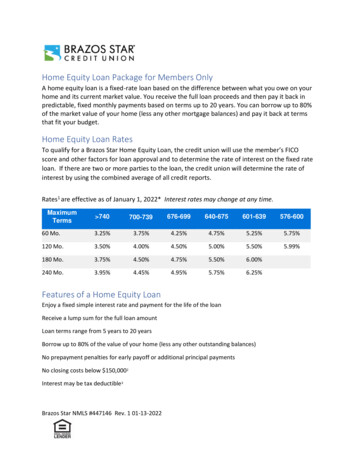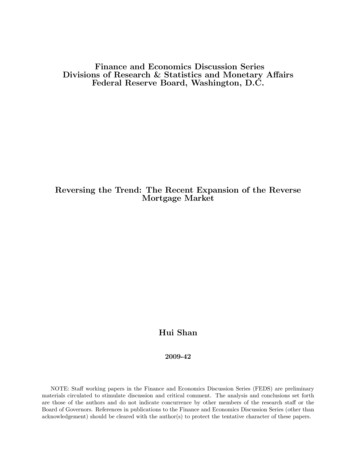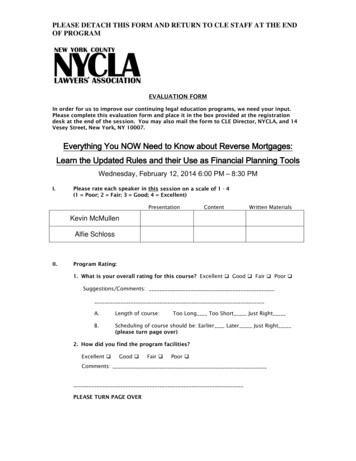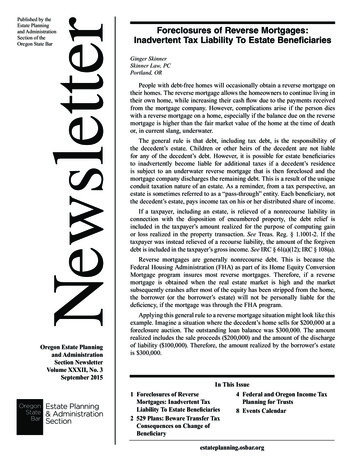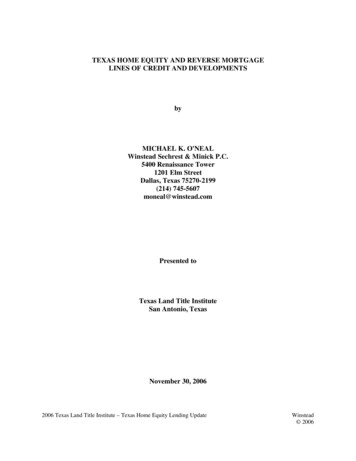
Transcription
TEXAS HOME EQUITY AND REVERSE MORTGAGELINES OF CREDIT AND DEVELOPMENTSbyMICHAEL K. O'NEALWinstead Sechrest & Minick P.C.5400 Renaissance Tower1201 Elm StreetDallas, Texas 75270-2199(214) 745-5607moneal@winstead.comPresented toTexas Land Title InstituteSan Antonio, TexasNovember 30, 20062006 Texas Land Title Institute – Texas Home Equity Lending UpdateWinstead 2006
Michael K. O'NealMichael K. O'Neal is a shareholder in the Dallas office of Winstead Sechrest & MinickP.C. His practice area focuses on the corporate and regulatory representation of financialinstitutions. He advises on matters including formations, acquisitions, investments, lending,enforcement and compliance. He also advises on consumer finance issues including home equitylending and other mortgage banking matters.Mr. O'Neal writes and speaks frequently on banking and consumer finance issues. Hehas spoken on home equity lending to, among others, the following: the 2005 and 2006 TexasMortgage Bankers Association Servicing Conferences, the 14th and 15th Annual Robert C.Sneed Texas Land and Title Institutes, the 38th Annual William W. Gibson, Jr. MortgageLending Institute, the State Bar's 1999 Advanced Real Estate Drafting Course, the State Bar's1999 Advanced Real Estate Law Course, the Texas Bankers Association, the 2006, 2005, 2004,2003, 2002, 2001, 2000 and 1998 Annual Conventions of the Texas Association of BankCounsel, the Houston Bar Association, the 25th, 26th, 27th, 30th, 31st and 32nd Annual LegalConferences sponsored by the Texas Savings & Community Bankers Association and theIndependent Bankers Association of Texas, the Spring Meeting of the Conference on ConsumerFinance Law, the Dallas Bar Association, the Consumer Home Equity and Mortgage LendingSeminar, the Subprime Lending and Finance Seminar, the Texas Real Estate TeachersAssociation, and several lenders.Mr. O'Neal has prepared a Texas Home Equity Lending Guide which is available fromthe Texas Bankers Association (512.472.8388 or www.texasbankers.com).Mr. O'Neal is the President of the Texas Association of Bank Counsel, on the GoverningCommittee of the Conference on Consumer Finance Law, and on the Commissioner's Council ofthe Texas Department of Banking. He served on the Texas Banking Code Revision Task Forceand the Texas Interstate Branching Task Force. He graduated with distinction from theUniversity of Nebraska School of Law in 1986.Winstead Sechrest & Minick P.C. is a full service law firm with offices in Austin, Dallas,Fort Worth, Houston, San Antonio, The Woodlands and Washington, D.C.2006 Texas Land Title Institute – Texas Home Equity Lending UpdateWinstead 2006
Table of ContentsI.II.III.IV.V.VI.VII.VIII.INTRODUCTION AND BACKGROUND .1CURRENT DEVELOPMENTS .2HOME EQUITY LOANS.4A.Home Equity Loans ("HELs") .4B.Home Equity Lines of Credit ("HELOCs") .26INTERPRETATIONS .33A.Interpretive Authority and Development .33B.ACORN Suit Challenging the Interpretations .35LITIGATION.38A.Debt Repayment Cases .39B.Lawsuits Regarding Adjustable Rate Home Equity Loans.40C.Agricultural Property and Equitable Subrogation.41CURES.43TEXAS LEGISLATION .45REVERSE ""I"DescriptionRevised and Re-Adopted InterpretationsAmended InterpretationACORN – Letter dated October 7, 2005 from Judge Scott H. JenkinsACORN – Final Summary Judgment and Temporary Stay OrderACORN – Letter dated August 31, 2006 from Clerk Diane O'NealCommissions ResolutionValue Limit ExamplesMortgagee Letter 2006-06Reverse Mortgage Lender Letter 2006-22006 Texas Land Title Institute – Texas Home Equity Lending UpdatePage iWinstead 2006
TEXAS HOME EQUITY AND REVERSE MORTGAGELINES OF CREDIT AND DEVELOPMENTSI.INTRODUCTION AND BACKGROUNDIn 1997, the 75th Texas Legislature adopted and voters approved the most significantchanges to the Texas homestead law since enactment of the state's first Constitution1 andsimultaneously joined every other state in allowing homeowners to borrow against the equitybuilt up in their residences.2 HJR 31 took effect January 1, 1998 and amended Article XVI,Section 50 of the Texas Constitution to broaden the types of liens that validly may be secured by"homestead" property.3 As amended, Section 50(a)(6) of the Texas Constitution permits acategory of authorized lien on the homestead commonly known as a home equity loan. Section50(a)(7) permits an authorized lien for a reverse mortgage.In 2003, the 78th Texas Legislature adopted and voters approved a constitutionalamendment, SJR 42, which addressed certain concerns pertaining to home equity loans, andauthorized a form of revolving home equity line of credit (i.e., "HELOCs") that allows Texashomeowners to borrow money secured by their homes in draws from time to time when a needarises, subject to minimum draw, maximum credit limit, and other restrictions. The resolutiontook effect on September 29, 2003.4In 2005, the 79th Texas Legislature adopted and voters approved a constitutionalamendment, SJR 7, which authorized line-of-credit advances under a reverse mortgage.1234Texas laws protecting the homestead are expansive and deeply rooted. Homestead rights trace back toTexas' days as a republic, prior to admission into the Union. See Act of Jan. 26, 1839, 1839 Laws of Rep.of Tex. 1236.House Joint Resolution 31 ("HJR 31") amending the Texas Constitution was presented to the voters asProposition 8 on the November 4, 1997 ballot. Articles discussing Texas home equity lending include:Michael K. O'Neal, Update on Texas Home Equity Lending, 56 Consumer Fin. L. Q. Rep. 117 (2002); JuliaPatterson Forrester, Home Equity Loans in Texas: Maintaining the Texas Tradition of HomesteadProtection, 55 S.M.U. L. Rev. 157 (2002); Charles C. Boettcher, Comment, Taking Texas Home Equity ForA Walk, But Keeping It On A Short Leash, 30 Tex. Tech L. Rev. 197 (1999); and J. Alton Alsup, Pitfalls(and Pratfalls) of Texas Home Equity Lending, 52 Consumer Fin. L. Q. Rep. 437 (1998).All references are to Article XVI of the Texas Constitution and are hereinafter omitted. Prior to HJR 31,the Texas Constitution provided an exhaustive list of five exceptions to the prohibition of the forced sale ofthe homestead for the payment of debts: 1) purchase money; 2) taxes due thereon; 3) an owelty of partitionresulting from a division of a family homestead in a divorce, 4) a refinance of a lien on the homestead,including a federal tax lien; and 5) work and materials used in the construction of improvements thereon.These exceptions were based upon the purpose for which the debt was incurred or the use of the proceeds,or both. For example, a consumer could encumber the homestead only to the extent that the lien secured adebt arising from the purchase price of the homestead, taxes paid on the homestead, or construction ofimprovements made to the homestead.On September 29, 2003, Governor Perry formally certified the ballot results of the September 13, 2003election.2006 Texas Land Title Institute – Texas Home Equity Lending UpdatePage 1Winstead 2006
Home Equity Loans – Basic Overview. Home equity loans are popular for several reasons.One reason is the favorable tax treatment (interest is generally tax deductible). Anotheradvantage is the relatively low interest rates on home equity loans compared with most otherforms of consumer credit. For some homeowners, particularly those who encounter significantdisruptions in income (for example, job loss) or large and perhaps unexpected claims on theirincome (for example, large medical expenses), drawing upon the equity in their homes may bethe only means available to obtain needed funds.The equity that accumulates in homes is one of the largest components of household wealth.Home equity credit is a way homeowners can convert their home equity (which is the differencebetween the home's market value and its outstanding mortgage debt) into spendable funds.Home equity credit generally takes either of two forms. One, referred to here as a "traditionalhome equity loan," is a closed-end loan extended for a specified length of time and requiresrepayment of interest and principal in equal periodic installments. The second form, a "homeequity line of credit," is a revolving account that permits borrowing from time to time at theaccount holder's discretion up to the amount of the credit limit.This paper is intended to provide an overview regarding Texas home equity and reversemortgage lines of credit and certain developments attendant to the same. THIS PAPER ISNOT A DEFINITIVE EXPLANATION OF THE TEXAS HOME EQUITY OR REVERSEMORTGAGE LENDING LAW AND IT IS NOT INTENDED AND SHOULD NOT BERELIED UPON AS LEGAL ADVICE REGARDING THE MEANING OF ANYPROVISION OF THE LAW.II.CURRENT DEVELOPMENTSIn 2006 to date, a variety of developments have occurred pertaining to Texas home equitylending including the following: 56Courts considered and decided various cases pertaining to home equitylending. (See "Litigation"). A significant decision was rendered onApril 29, 2006 in Association of Community Organizations for ReformNow (ACORN), et al. v. Finance Commission of Texas, et al,5 a case inwhich the plaintiffs challenged the validity of nine interpretations adoptedby the Finance Commission and Credit Union Commission (the"Commissions").6A copy of the Final Summary Judgment andTemporary Stay Order is attached as Exhibit "D" in which the courtconcluded that seven interpretations adopted by the Commissions areinvalid and denied relief with respect to two others. The Commissions,the plaintiffs and an intervenor, the Texas Bankers Association ("TBA"),have appealed. The order included a temporary stay for 30 days. TheNo. GN 400269 (126th Dist. Ct., Travis County, Tex. Apr. 29, 2006).The Finance Commission and Credit Union Commission have been granted the authority to issueinterpretations pertaining to the home equity constitutional provisions. See "Interpretations."2006 Texas Land Title Institute – Texas Home Equity Lending UpdatePage 2Winstead 2006
Third Court of Appeals has now extended the stay until disposition of theappeal.7 (See "ACORN Suit Challenging the Interpretations").78910111213 A court decided that homestead property, if subsequently re-designated foragricultural use by a borrower of a home equity loan, is protected fromforced sale under Section 50(a)(6)(I), regardless of how the property wasdesignated when the borrower incurred the debt.8 (See "Litigation"). The Fourth Court of Appeals withdrew a panel opinion and substituted anopinion which provides, among other things, the doctrine of equitablesubrogation cannot be applied to circumvent the penalty of forfeiture.9(See "Litigation"). The Commissions repealed, revised and re-adopted three home equityinterpretations: 7 Tex. Admin. Code § 153.13 (Preclosing Disclosure); 7Tex. Admin. Code § 153.18 (Limitation on Application of Proceeds); and7 Tex. Admin. Code § 153.20 (No Blanks in Any Instrument)10 (See"Interpretations"). Four state agencies issued a Legal Advisory regarding a typographicalerror in recently re-adopted 7 Tex. Admin. Code § 153.13. The Commissions adopted an amendment to 7 Tex. Admin. Code § 153.13to correct the typographical error.11 The amendment took effectNovember 9, 2006. (See "Interpretations"). The Commissions decided not to repeal and readopt a home equityinterpretation, 7 Tex. Admin. Code § 153.22, pertaining to documentcopies.12 (See "Interpretations"). The Commissions adopted a resolution recommending the 80th TexasLegislature consider constitutional amendments to clarify the Texas homeequity lending provisions.13 On September 25, 2006, Fannie Mae and Freddie Mac announced the jointavailability of non-executable Spanish translations of Fannie Mae/FreddieMac Uniform Instruments, including certain Texas home equityLetter dated August 31, 2006, from Diane O'Neal, Clerk, Court of Appeals, Third District of Texas, a copyof which is attached as Exhibit "E".Marketic v. U.S. Bank Nat'l Ass'n, 436 F. Supp. 2d 842 (N.D. Tex. 2006).LaSalle Bank National Ass'n v. White, 2006 WL 2871278 (Tex. App.-San Antonio Oct. 11, 2006).31 Tex. Reg. 5080 (June 23, 2006)(effective June 29, 2006), a copy of which is attached as Exhibit "A".31 Tex. Reg. 9022 (Nov. 3, 2006) adopting without change proposal published in 31 Tex. Reg. 7076(Sept. 1, 2006), a copy of which is attached as Exhibit "B".31 Tex. Reg. 8981 (Nov. 3, 2006).The Commissions adopted the resolution at their October 20, 2006 meeting, a copy of which is attached asExhibit "F".2006 Texas Land Title Institute – Texas Home Equity Lending UpdatePage 3Winstead 2006
instruments. The forms are available at www.efanniemae.com andwww.freddiemac.com/uniform.III.HOME EQUITY LOANSUnder Texas law, no mortgage, trust deed, or other lien may ever be properly fixed on thehomestead14 unless it secures a type of indebtedness expressly authorized by the TexasConstitution.15 The only permitted liens that may be lawfully created upon a homestead propertyunder Texas law are prescribed under Sections 50(a)(1)-50(a)(8), respectively, of the TexasConstitution. Section 50(a)(6) authorizes what are commonly known as "home equity loans."Sections 50(a)(6) and 50(t) authorize home equity lines of credit, commonly known as HELOCs.For lenders considering making home equity loans in Texas and counsel advising them,understanding the home equity constitutional provisions is essential.A.Home Equity Loans ("HELs")Since January 1, 1998, the Texas Constitution has permitted liens16 to be taken againsthomesteads to secure loans based on the owner's equity in his or her homestead (hereafter "homeequity" or "equity" loans), subject to all of the conditions, restrictions and requirements set forthin Section 50(a)(6). Certain provisions are discussed below.1.Fee Limitation. One of the most significant but difficult provisions ofSection 50(a)(6) is the limit on the amount of fees that may be charged to make equity loans.According to the Texas Constitution, lenders may not charge or cause the borrower to pay fees inexcess of 3% of the original principal amount of an equity loan (e.g. 3,000 on a 100,000loan).17 The cap relates to any required fees that are necessary to originate, evaluate, maintain,record, insure, or service the loan.The interpretations18, and their predecessor the Commentary,19 address numerous feeissues. An interpretation, 7 Tex. Admin. Code § 153.5, states, in pertinent part, the following:141516171819Section 50 of the Texas Constitution invalidates any lien against the "homestead," unless the lien secures adebt described by that provision. Homestead property is a place used as a home or as a place to exercise acalling or business for a family or a single, adult person. Tex. Const. art. XVI, § 50; Tex. Prop. Code §41.002. Accordingly, certain residential real estate is homestead property (e.g., property used as primaryresidence), and other residential real estate property is not (e.g., vacation home, rental property).See Section 50(c); Tex. Prop. Code § 41.001(b).Section 50(q) provides that any Texas statutes, including Tex. Prop. Code § 41.001, that purport to limitencumbrances that may be fixed on homesteads are superseded to the extent that such encumbrances arepermitted for home equity loans and reverse mortgages.Section 50(a)(6)(E). This section provides that a lender may not "require the owner or the owner's spouseto pay, in addition to any interest, fees to any person that are necessary to originate, evaluate, maintain,record, insure, or service the extension of credit that exceed, in the aggregate, three percent of the originalprincipal amount of the extension of credit."See "Interpretations" discussed below.Following vote approval of the home equity provisions, the OCCC; the Texas Department of Banking; theTexas Savings & Loan Department, and Texas Credit Union Department developed a regulatorycommentary (the "Commentary") pertaining to home equity loans, the latest version of which is dated2006 Texas Land Title Institute – Texas Home Equity Lending UpdatePage 4Winstead 2006
(1) Optional Charges. Charges paid by an owner or an owner's spouse at theirsole discretion are not fees subject to the three percent fee limitation. Chargesthat are not imposed or required by the lender, but that are optional, are not feessubject to the three percent limitation. The use of the word "require" inSection 50(a)(6)(E) means that optional charges are not fees subject to the threepercent limitation.(3) Charges that are Interest. Charges an owner or an owner's spouse is requiredto pay that constitute interest20 under the law, for example per diem interest andpoints, are not fees subject to the three percent limitation.(15) Subsequent Events. The three percent limitation pertains to fees paid orcontracted for by an owner or owner's spouse at the inception or at the closing ofan equity loan. On the date the equity loan is closed an owner or an owner'sspouse may agree to perform certain promises during the term of the equity loan.Failure to perform an obligation of an equity loan may trigger the assessment ofthe costs to the owner or owner's spouse. The assessment of costs is a subsequentevent triggered by the failure of the owner's or owner's spouse to perform underthe equity loan agreement and is not a fee subject to the three percent limitation.Examples of subsequent event costs include contractually permitted charges forforce-placed homeowner's insurance costs, returned check fees, debt collectioncosts, late fees, and costs associated with foreclosure.212021October 7, 1998. The guidelines are entitled "Regulatory Commentary on Equity Lending Procedures" andare available at the OCCC's website (www.occc.state.tx.us).The term "interest" is defined as "defined in Texas Finance Code § 301.002(4) and as interpreted by thecourts." 7 Tex. Admin. Code § 153.1(11). [The definition may contain a typo as the correct citationappears to be Tex. Fin. Code § 301.002(a)(4).]7 Tex. Admin. Code § 153.5. PiersonPatterson, LLP has a website (www.ppdocs.com) containing helpfulhome equity information. Under "Library", the site contains various sample forms. Under "Tools", the sitecontains various resources including a "Texas Home Equity Allowed Fees and Charges" summary. Byreferencing the foregoing resources, the author makes no assurances or warranties pertaining to the sameincluding that they comply with applicable law.2006 Texas Land Title Institute – Texas Home Equity Lending UpdatePage 5Winstead 2006
Development – ACORN Order Holding Interpretations Invalid. On January 29, 2004, theAssociation for Community Organizations for Reform Now ("ACORN") and six individualsfiled a petition against the Finance Commission and Credit Union Commission in the DistrictCourt of Travis County (126th Judicial District) challenging the validity of certain interpretationsadopted by the Commissions. Association of Community Organizations for Reform Now(ACORN), et al. v. Finance Commission of Texas, et al., No. GN 400269, 126th Dist. Ct., TravisCounty, Texas. The plaintiffs ultimately challenged the validity of nine home equityinterpretations. The validity was challenged generally as follows: (A) some interpretations arenew rules which the Commissions had no authority to enact; or (B) the Commissions exceededtheir authority to interpret the Texas Constitution because some interpretations contradict theplain meaning and intent of the constitutional provisions, and some impose additional burdensand restrictions in excess of or inconsistent with the constitutional provisions. On April 29,2006, District Judge Scott Jenkins issued a Final Summary Judgment and Temporary Stay Order,a copy of which is attached as Exhibit "D". Judge Jenkins determined the followinginterpretations are invalid:1.Three Percent Fee Cap Rules: 7 Tex. Admin. Code §§ 153.1(11),153.5(3), (4), (6), (8), (9) and (12).2.Closing Date – Oral Application Rule: 7 Tex. Admin. Code § 153.12(2).3.Preclosing Disclosure – Fee Variance Rule:§ 153.13(4).4.Limitation on Application of Proceeds – Debt Consolidation Rule: 7 Tex.Admin. Code § 153.18(3).5.Blank Spaces Rule: 7 Tex. Admin. Code § 153.20.6.Document Copy Rule: 7 Tex. Admin. Code § 153.22.7.HELOC Advance Devices and Methods Rule:§ 153.84(1).7 Tex. Admin. Code7 Tex. Admin. CodeHe denied the plaintiffs' relief pertaining to the following:1.Location of Closing – Power of Attorney Rule:§§ 153.15(2), (3).7 Tex. Admin. Code2.Customer Disclosure (Notice Concerning Extensions of Credit) –Disclosure Mailing Rule: 7 Tex. Admin. Code §§ 153.51(1), (3).Appeals are pending and a stay is in place. See "ACORN Suit Challenging the Interpretations."2006 Texas Land Title Institute – Texas Home Equity Lending UpdatePage 6Winstead 2006
Development – ACORN Decision on Fee Cap Rule. In ACORN, the plaintiffs challenged theinterpretations, 7 Tex. Admin. Code §§ 153.1(11) and 153.5(3), (4), (6), (8), (9) and (12),pertaining to charges which are considered interest and not fees subject to the three percent feelimitation. Judge Jenkins ruled for the plaintiffs. In a letter dated October 7, 2005 in whichJudge Jenkins informed the parties on how he intended to rule, Judge Jenkins states:Under the agencies' rules, and in particular Rule 153.5(3), a lender could charge apoint to originate the loan, a point to evaluate the loan, a point to maintain theloan, and a point to service the loan, and even though none of those points boreany relationship to the monthly interest rate being charged to the borrower, theywould not be subject to the three percent cap. In fact, it would not matter whetherany of these charges were in the form of points. Because all of these charges bythe lender are considered, at present, interest (as that term is technically defined inusury law), they are not subject to the three percent fee cap. Because this seemsso contrary to the clear language, purpose and intent of Article 16,Section 50(a)(6)(E), I have decided to rule for the Plaintiffs on this point.Judge Jenkins also notes, among other things, the following: "Furthermore, adopting Defendants' use of usury law to interpret theConstitution so that it is 'consistent' would mean that any change in usurylaw by the legislature could necessarily dictate a new and differentinterpretation of the Constitution." "The agencies did not specify 'discount points.' The agencies elected tomerely use the word 'points' in 153.5(3). As we all know, all points arenot discount points. Discount points are essentially pre-payment ofinterest." " it seems to this Court that since discount points are clearly apre-payment of interest and measurably correspond to a lower monthlyinterest rate, it would be reasonable to have a rule that discount points arenot subject to the three percent cap."The decision may impact whether origination fees and points are within the three percent feelimit. The order may support the conclusion that they are. Other cases and Judge Jenkins' letterreflect a position that discount points (i.e., points paid for reducing the interest rate) are a form ofinterest and, therefore, not fees within the three percent limit. Nonetheless, the order may createuncertainty on this issue as well. See "ACORN Suit Challenging the Interpretations."Practice Tip – Voluntary Nature. Lenders should take care when exempting a charge on theground that it is not "required." The charge should be truly optional and truly voluntary.2006 Texas Land Title Institute – Texas Home Equity Lending UpdatePage 7Winstead 2006
2.Agricultural Property Exclusion. An equity loan secured by a homesteadproperty designated for agricultural use as provided by statutes governing property tax22 is notpermitted, unless the homestead is used primarily for the production of milk.23Practice Tip – Impermissible Agricultural Property Cure. A failure to comply is frequentlysignificant. If a home equity loan purports to be secured by any homestead property designatedfor agricultural use prohibited by Section 50(a)(6)(I), the lender or holder may cure by sendingthe owner a written acknowledgment that the loan is not secured by any impermissibleagricultural property pursuant to Section 50(a)(6)(Q)(x)(b). A violation may involve asignificant amount of impermissible agricultural property24 and may also implicate otherconstitutional provisions.Development – Agricultural Property Case. In LaSalle Bank National Association v. White,2006 WL 2871278 (Tex. App.-San Antonio Oct. 11, 2006), the court addressed whether thehome equity loan was secured by homestead property designated for agricultural use. Theproperty, with the exception of one acre, was "qualified open-space land" and was valued underSubchapter D of the Texas Property Tax Code. The court concludes "that article XVI, section50(a)(6)(I)'s use of the phrase 'designated for agricultural use as provided by statutes governingproperty tax' refers to land put to an agricultural use as defined by, and assessed for tax purposesunder both subchapter C and subchapter D of the Tax Code." White, 2006 WL 2871278 at *4(See Tex. Prop. Tax Code ch. 23, Subchapters C and D.) The court also held that "BecauseWhite's land was 'designated for agricultural use as provided by [subchapter D of] [the]property tax [code].' the Texas Constitution prohibited it from being used as security for a homeequity loan." White, 2006 WL 2871278 at *5. See "Litigation".Development – Agricultural Property Case; Subsequent Designation. In Marketic v. U.S.Bank Nat'l Ass'n, 436 F. Supp. 2d 842 (N.D. Tex. 2006), a court decided that homesteadproperty, if subsequently designated for agricultural use by a borrower of a home equity loan, isprotected from forced sale under Section 50(a)(6)(I), regardless of how the property wasdesignated when the borrower incurred the debt. See "Litigation".3.Only One Equity Loan at a Time. The homestead may be encumbered withonly one equity loan at a time.25 Any other debt concurrently secured by the homestead must be22232425See e.g., Tex. Prop. Tax Code ch. 23, Subchapter C (§§ 23.41-23.47). A tract is "designated" foragricultural use by the chief appraiser of the appraisal district in which the tract is located upon annualsworn application made by the homestead claimant. Tex. Prop. Tax Code §§ 23.43, 23.44.Section 50(a)(6)(I).It is not uncommon for a rural property to have a small portion of the tract subject to homestead taxexemption with the remainder subject to agricultural use assessment.Section 50(a)(6)(K). The homestead may be encumbered with only one equity loan at a time. Any otherdebt concurrently secured by the homestead must be one of the other types of permitted encumbrancesspecified in the Texas Constitution. The cited subsections generally provide the following exceptions tothe prohibition on the forced sale of the homestead for the payment of debts:SubsectionCategory(a)(1)purchase money(a)(2)taxes due thereon2006 Texas Land Title Institute – Texas Home Equity Lending UpdatePage 8Winstead 2006
one of the other types of permitted encumbrances specified in the Texas Constitution, except thatan equity loan may not encumber a homestead that is also encumbered by a reverse mortgage.26An interpretation says, "If under Texas law the property ceases to be the homestead of the owner,then the lender, for purposes of Section 50(a)(6)(K), may treat what was previously a homeequity mortgage as a non-homestead mortgage."27Practice Tip – Only One. HELOCs are a type of equity loan. Accordingly, a borrower mayhave either an equity loan or a HELOC, but not both.Practice Tip – Additional Home Equity Loan Cure. A failure to comply with Section50(a)(6)(K) is significant. If a lender has made an equity loan on a homestead property thatalready has an equity loan secured on the same property in violation of Section 50(a)(6)(K), thelender or holder may cure by sending the owner a written acknowledgment that the accrual ofinterest and all of the owner's obligations under the loan are abated while the prior equity loanremains secured by the same homestead property.28Practice Tip – Borrower's Knowledge of Limitations. Many consumers either don't know ordon't understand the limitations that a homeowner may have only one home equity loan and thatthe owner cannot refinance an equity loan for one year other than to facilitate a cure. Lendersshould clearly explain these limitations. Of course, purchase money loans and homeimprovement loans are not considered home equity loans; therefore, a homeowner may haveeach of these loans in addition to a home equity loan.4.Payments. Prior to 2003, a home equity loan had to be repaid in substantiallyequal successive monthly installments beginning no later than two months after the date the loa
In 2005, the 79th Texas Legislature adopted and voters approved a constitutional amendment, SJR 7, which authorized line-of-credit advances under a reverse mortgage. 1 Texas laws protecting the homestead are expansive and deeply rooted. Homestead rights trace back to Texas' days as a republic, prior to admission into the Union.


